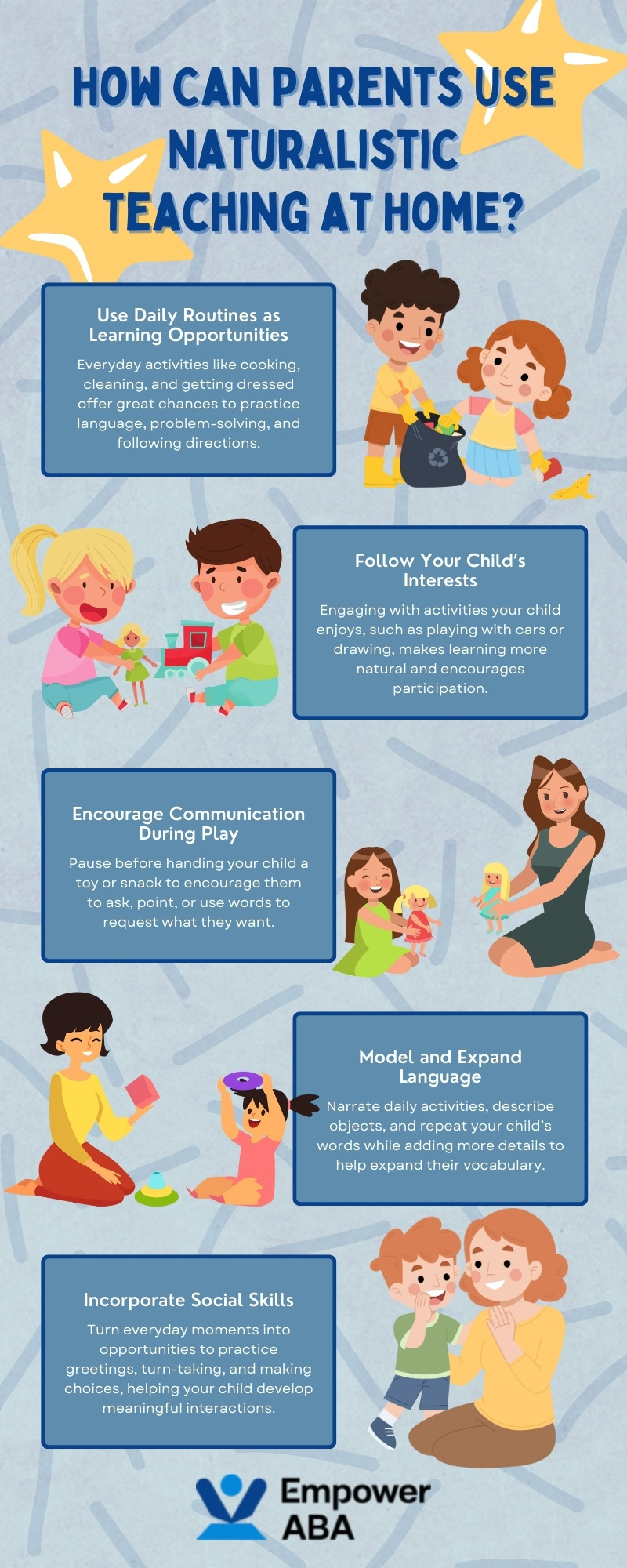Key Points:
- Naturalistic teaching in ABA is a child-led approach that uses real-world interactions to teach new skills.
- This method promotes learning through everyday activities, making lessons more engaging and meaningful.
- Parents and therapists can implement strategies like incidental teaching, pivotal response training, and modeling.
Think about how children pick up language—by hearing and using it in daily life. That’s the idea behind naturalistic teaching in ABA—helping kids learn by integrating lessons into everyday activities, rather than relying on rigid drills. This approach makes learning feel more like play, which keeps kids engaged and eager to grow.
What is Naturalistic Teaching in ABA?
Naturalistic teaching in ABA is a teaching method that focuses on learning through real-world experiences and interactions. Instead of structured, therapist-driven instruction, this child-led approach encourages learners to engage in learning naturally during play and everyday activities.
For example, instead of using flashcards to teach colors, a therapist might help a child identify colors while playing with their favorite toys. This makes the learning experience more engaging and relevant.

Why is Naturalistic Teaching Important in ABA Therapy?
Naturalistic teaching is essential in ABA therapy because it makes learning feel natural and engaging. Many traditional approaches rely on structured lessons, but children learn best when they are actively involved in meaningful activities. By integrating learning into daily life, naturalistic teaching helps children develop skills in a way that feels effortless and enjoyable.
One of the biggest advantages of this approach is that it encourages generalization. When children practice skills in real-world settings—rather than just during therapy sessions—they are more likely to use those skills across different environments, such as home, school, and social situations. This makes their progress more functional and long-lasting.
Additionally, naturalistic teaching supports motivation and engagement. Since lessons are built around the child’s interests, they are more likely to participate willingly. This reduces frustration and resistance to learning, making ABA therapy more effective. When children enjoy the learning process, they are more eager to explore new skills and apply them in everyday life.
What Are the Different Types of Naturalistic Teaching Strategies?
Naturalistic teaching in ABA includes several evidence-based strategies. Each one uses a child’s natural environment and interests to promote learning. Here’s a breakdown of the most common techniques:
1. Incidental Teaching
Incidental teaching involves creating opportunities for learning within daily activities. Instead of setting aside a specific time for instruction, therapists and parents wait for teachable moments to arise naturally.
- Example: If a child reaches for a snack, the parent can encourage them to use words or gestures to request it before handing it over.
- Why It Works: The child is motivated by their immediate desire, making it more likely they will engage in the learning process.
2. Pivotal Response Training (PRT)
PRT focuses on developing “pivotal” skills—core behaviors that lead to improvements in many other areas. It is particularly effective for improving communication and motivation.
- Example: Instead of prompting a child to name a toy, a therapist might model excitement while playing and wait for the child to initiate interaction.
- Why It Works: Encourages spontaneous speech and social engagement in a natural way.
3. Natural Environment Teaching (NET)
NET is all about using the child’s surroundings to teach new skills. The goal is to make learning feel like part of everyday life rather than a separate activity.
- Example: Teaching counting by counting steps as the child climbs stairs.
- Why It Works: The child learns through hands-on experience, making concepts easier to understand and remember.
4. Modeling
Modeling involves demonstrating a behavior or skill and encouraging the child to imitate it. This method is useful for teaching social skills, communication, and play behaviors.
- Example: A therapist might say “Hi” and wave at a peer, then encourage the child to do the same.
- Why It Works: Children learn by observing others, especially in familiar settings.
5. Mand-Model Approach
This strategy encourages verbal communication by prompting the child to make requests (mands). It starts with a prompt and gradually reduces support as the child gains confidence.
- Example: Holding up a toy and asking, “What do you want?” then reinforcing the child’s response.
- Why It Works: Helps children improve their ability to ask for what they need.
Parents play a crucial role in reinforcing naturalistic teaching outside of therapy. By incorporating learning into daily routines, they can help their child develop essential skills in a comfortable environment. Here are some practical ways to use naturalistic teaching at home:

Partner with Empower ABA for Personalized ABA Therapy
Understanding naturalistic teaching ABA definition is just the first step in helping your child learn in a way that feels natural and enjoyable. At Empower ABA, we specialize in using evidence-based ABA techniques tailored to each child’s needs. Our goal is to create meaningful learning experiences that help children develop essential life skills.
If you’re looking for ABA therapy services in New York, New Jersey, and Virginia, our team is here to support you. Contact Empower ABA today to learn more about how we can help your child thrive through naturalistic teaching methods!

